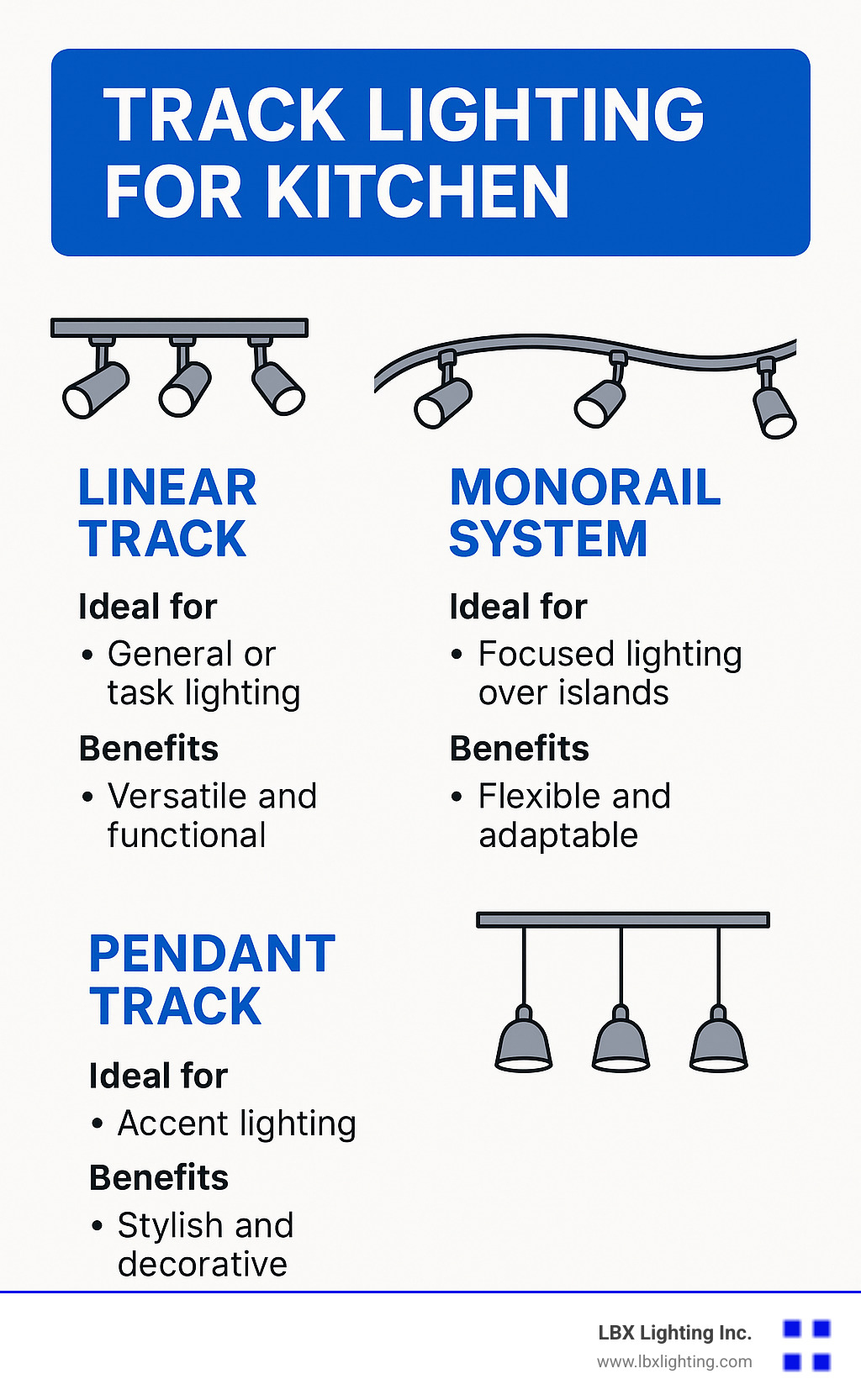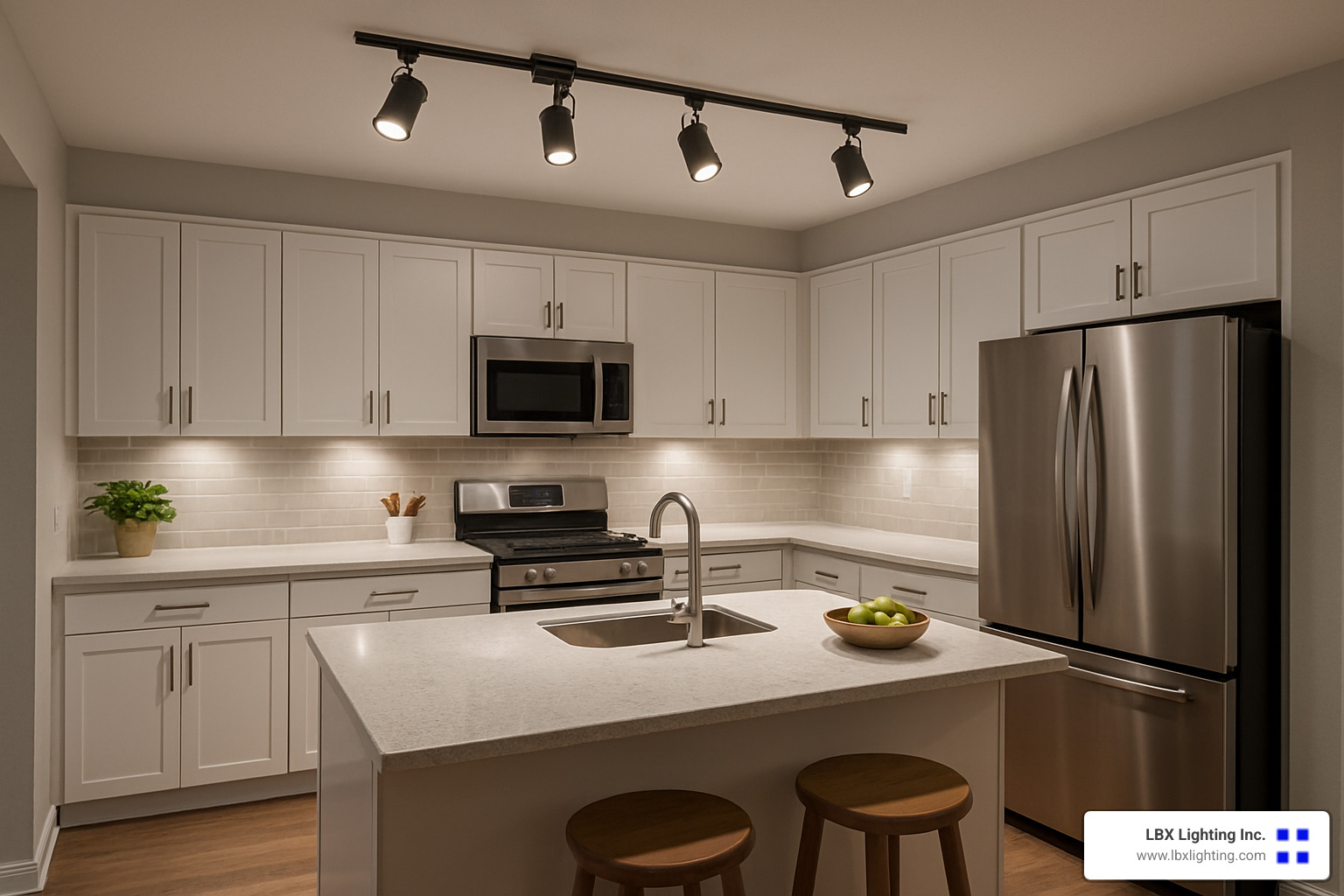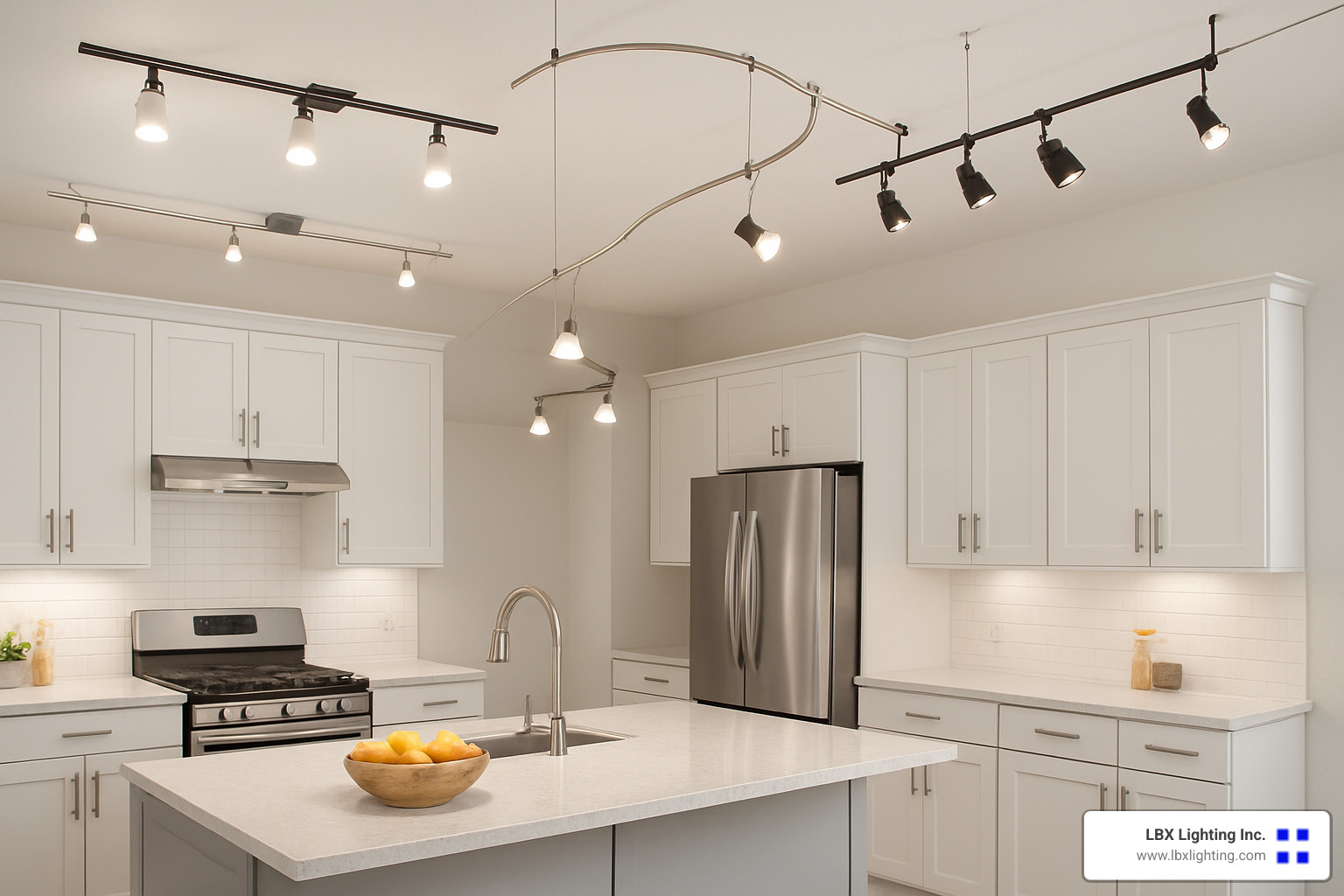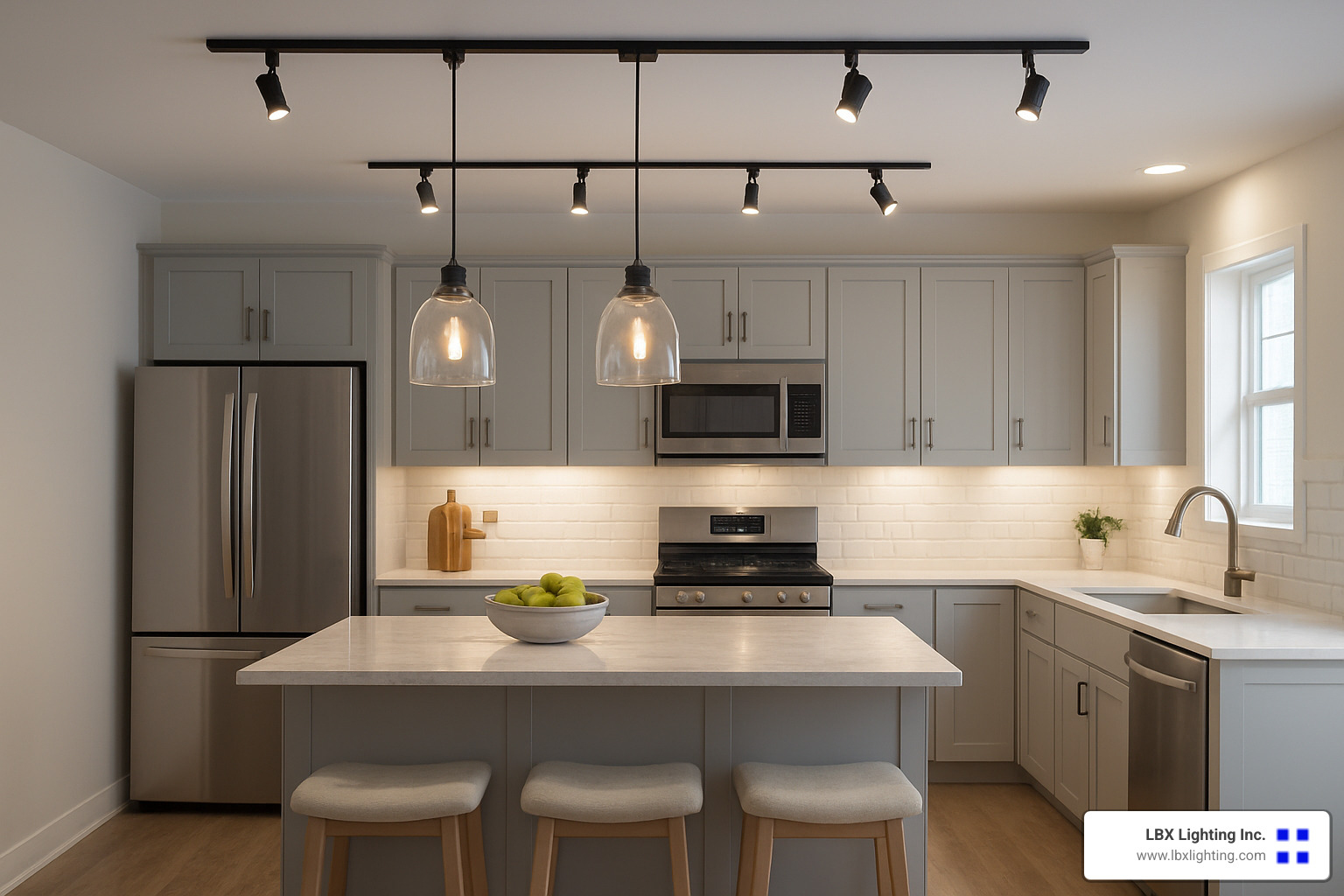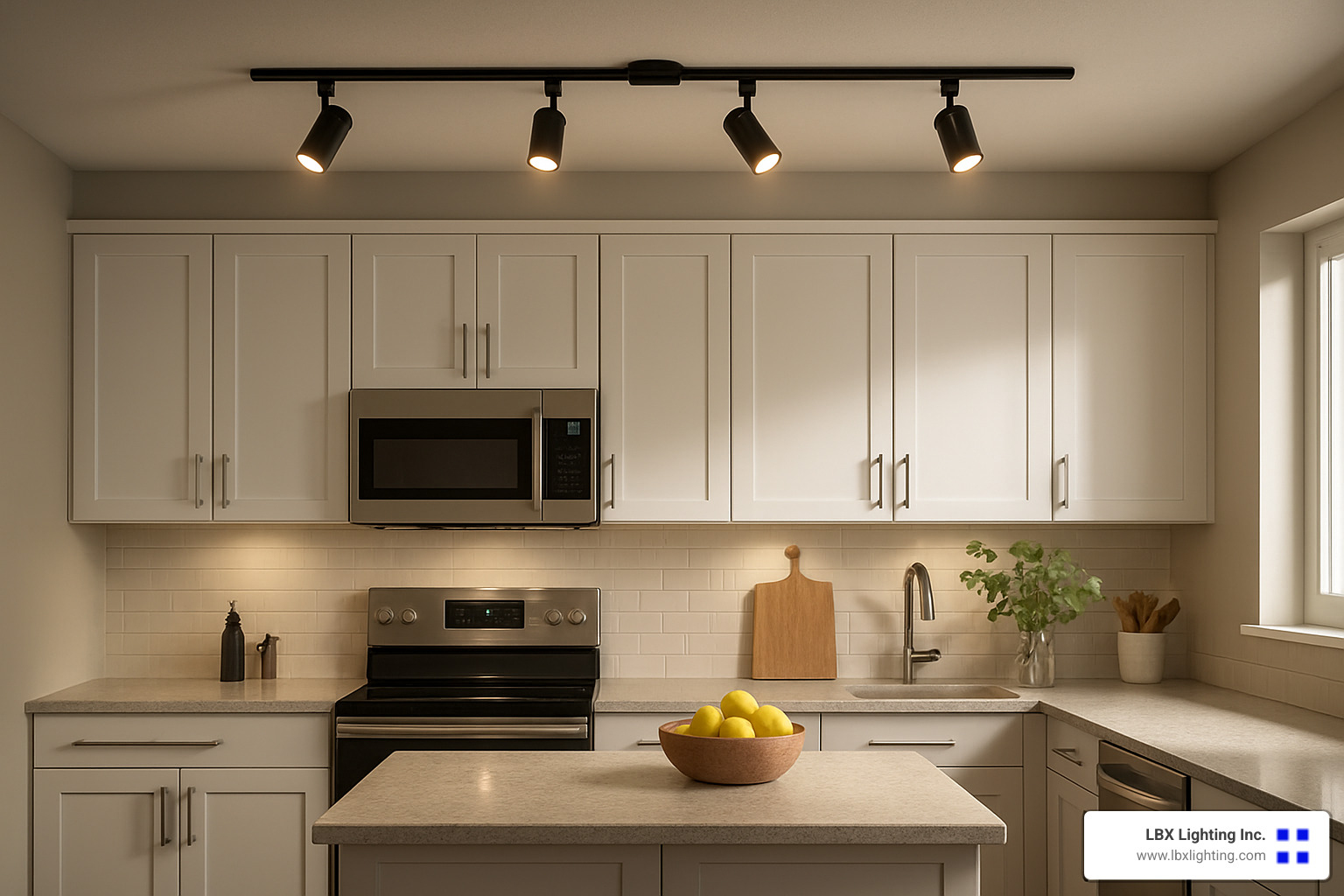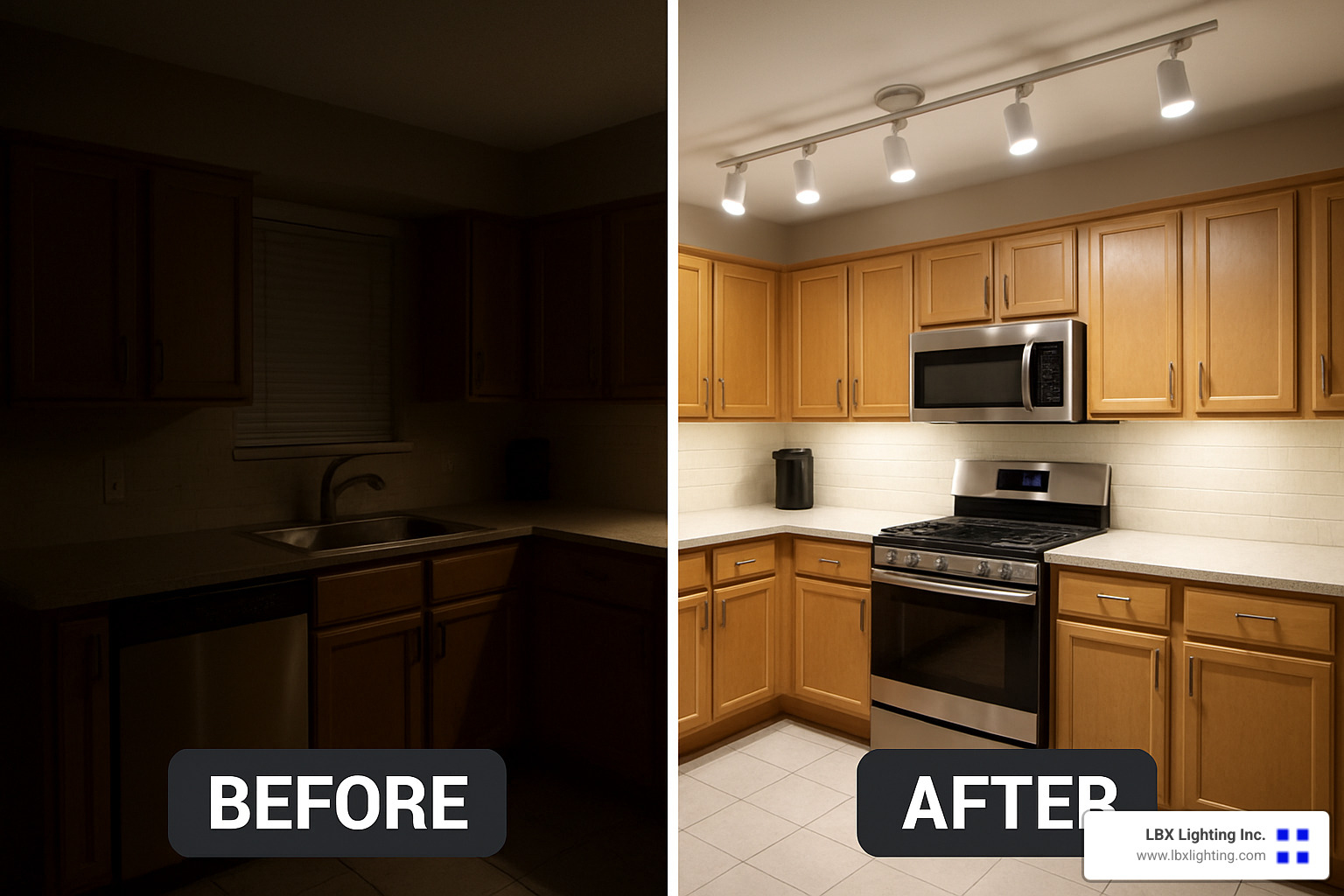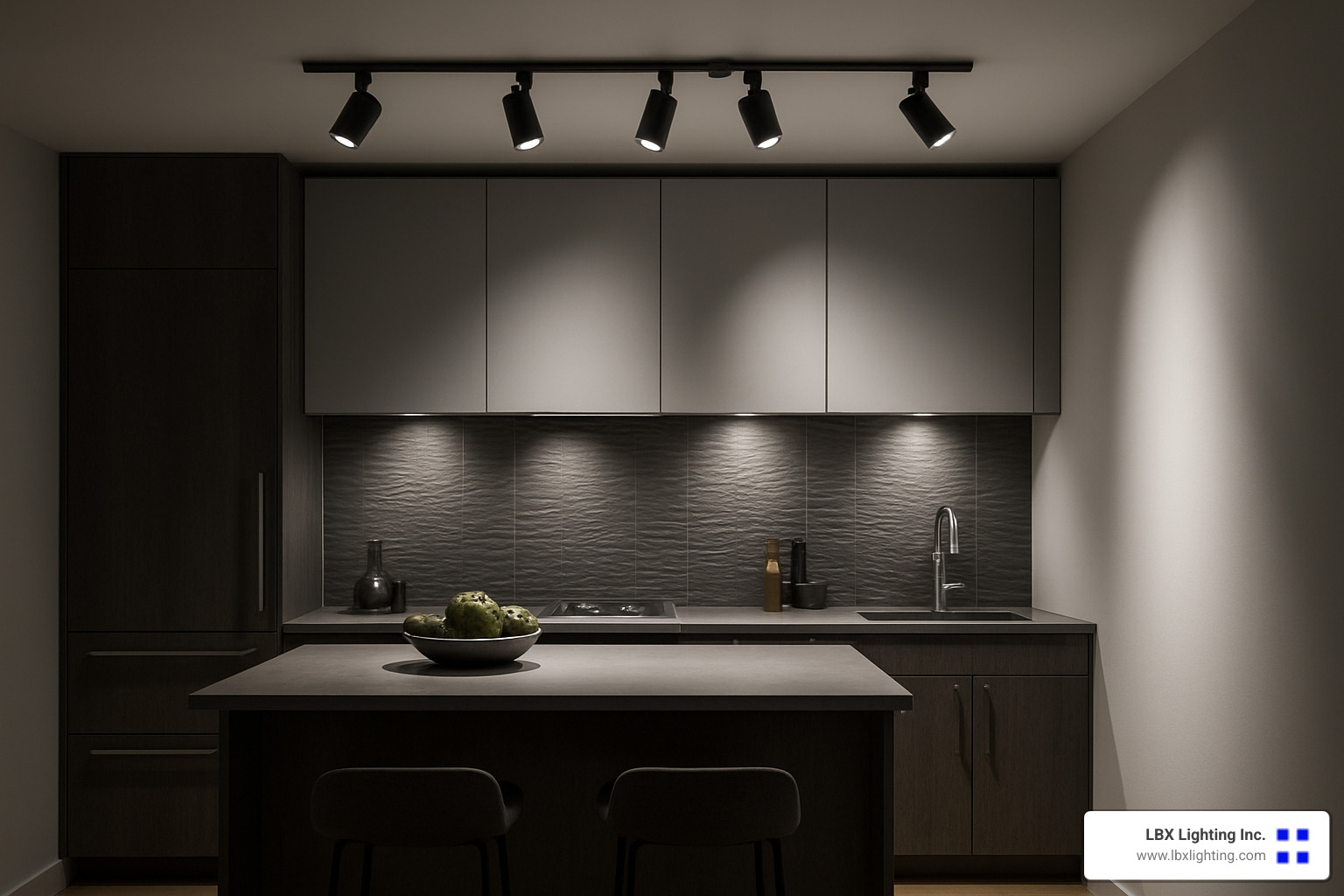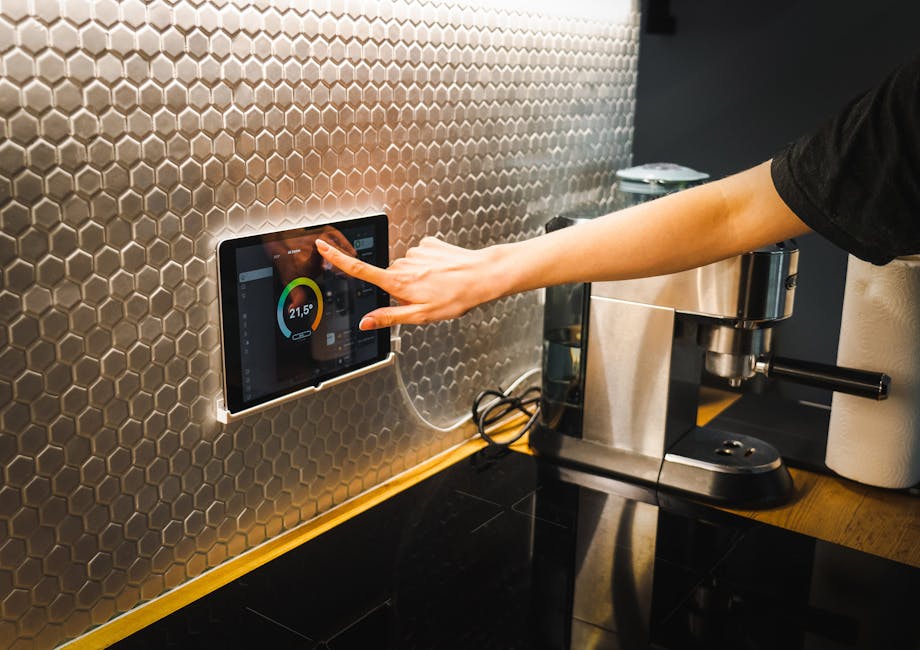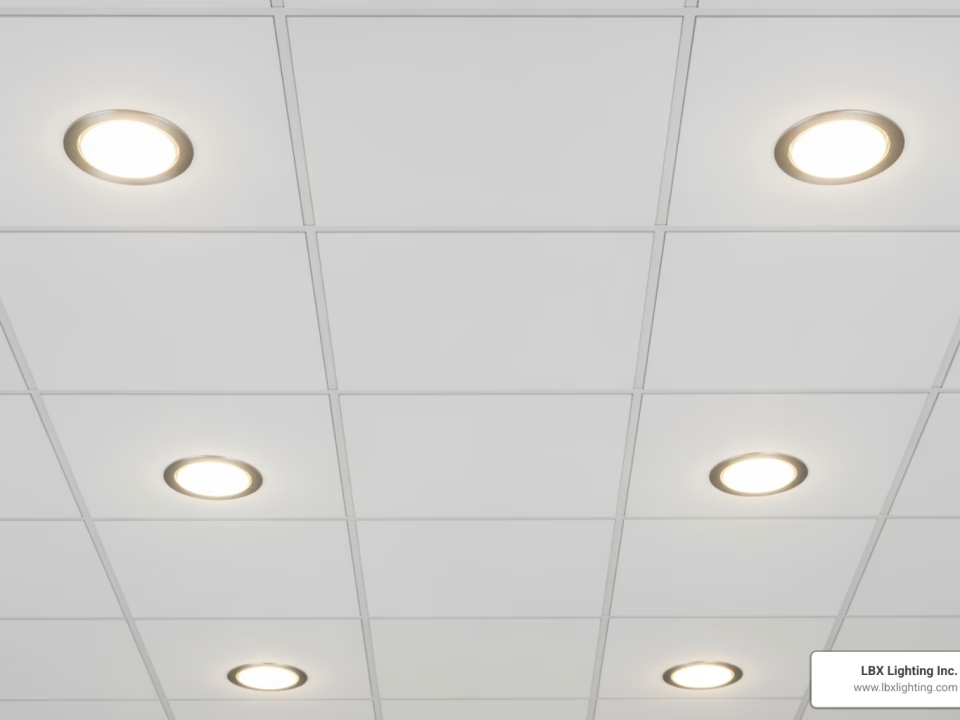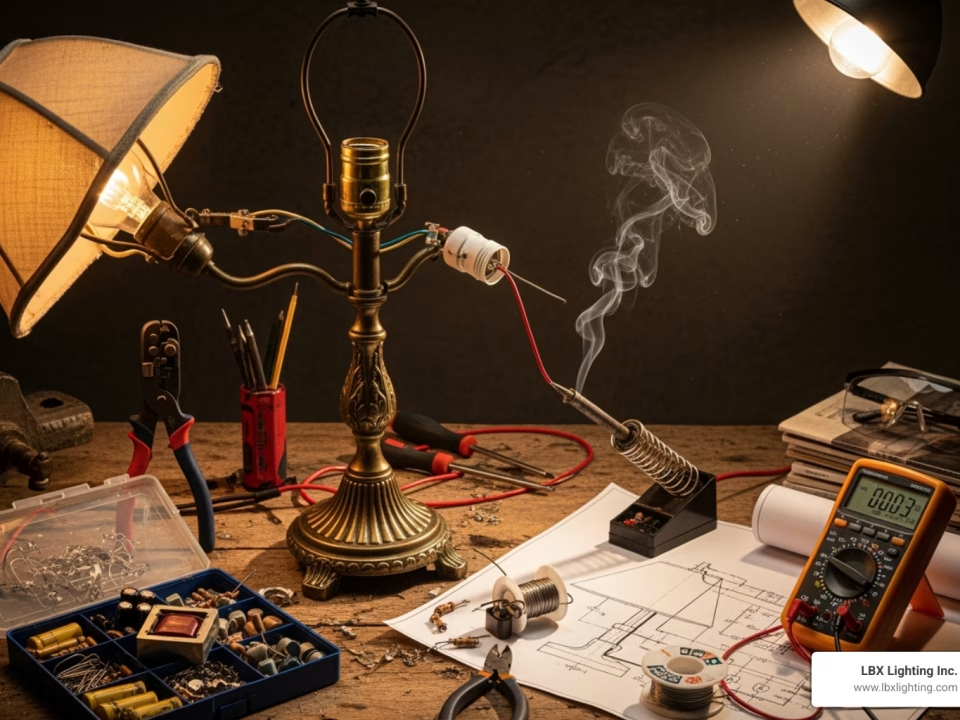
Don’t Be Left in the Dark—Your Guide to Houston Parking Lot Lighting
May 15, 2025
Mend the Glamour: Crystal Chandelier Repair Guide
May 20, 2025Illuminating Your Kitchen: Essential Track Lighting Basics
Track lighting for kitchen spaces offers a versatile and flexible lighting solution with adjustable heads that can be positioned exactly where you need light.
Here’s what you need to know about kitchen track lighting at a glance:
| Feature | Benefit |
|---|---|
| Adjustable heads | Direct light precisely where needed for food prep and cooking tasks |
| Flexible placement | Can be installed on ceilings, walls, or even beams for custom lighting |
| Energy efficiency | LED track lighting uses up to 85% less energy than traditional bulbs |
| Versatility | Works as task lighting over counters or ambient lighting for the whole space |
| Modern aesthetic | Available in sleek, contemporary designs that improve kitchen décor |
| Easy installation | Many systems can be DIY-installed with basic electrical knowledge |
Track lighting has evolved from the chunky industrial fixtures of the 1980s to sleek, modern designs that combine form and function. Today’s kitchen track lighting systems feature slim profiles, luxe finishes like brass and bronze, and energy-efficient LED technology that provides bright, clear illumination exactly where you need it.
Unlike fixed ceiling fixtures, track lighting gives you the freedom to redirect light as your needs change. This makes it perfect for kitchen spaces where you might need focused task lighting over a cutting board one moment and ambient lighting for entertaining the next.
I’m Michael Eftekhar, and with over 30 years of experience providing track lighting for kitchen installations throughout Houston and surrounding areas, I’ve helped countless homeowners transform their cooking spaces with versatile track lighting solutions that combine style and functionality.
Relevant articles related to track lighting for kitchen:
– battery operated led track lighting
– battery operated lighting
Why Track Lighting Belongs in the Kitchen
The kitchen is the heart of the home—a place where we prepare meals, gather with family, and often entertain guests. Proper lighting is essential in this multifunctional space, and track lighting for kitchen areas offers unique advantages that make it particularly well-suited for culinary environments.
Versatility That Adapts to Your Needs
One of the most significant benefits of track lighting is its adjustability. As one homeowner told us after we installed a system in their Houston kitchen, “It’s like having multiple lights in one. I can focus on my cutting board when prepping vegetables, then redirect the heads to illuminate my stovetop when cooking.”
This flexibility is invaluable in kitchens where different tasks require different lighting solutions. Unlike fixed recessed lighting, track systems allow you to reposition the light heads whenever your needs change—without calling an electrician. The adjustable heads can provide precise task lighting exactly where you need it or be angled to create a beautiful ambient wash across your space.
Energy Efficiency That Saves Money
Modern LED track lighting is remarkably energy-efficient. According to energy experts, LED track lighting can use up to 85% less energy than traditional incandescent bulbs while lasting up to 20 times longer. For a space like the kitchen that often has lights on for extended periods, these savings add up quickly.
A client in Texas who upgraded to LED track lighting in their kitchen shared with me, “We’re saving about $15 a month just from switching our kitchen lighting to LED track fixtures. Over the year, that’s $180 back in our pocket.” These eco-friendly statistics aren’t just good for your wallet—they’re better for the planet too.
Space-Saving Design
For kitchens with limited ceiling space or where recessed lighting isn’t feasible, track lighting provides an excellent alternative. The systems mount directly to the ceiling surface without requiring the cavity space that recessed lights need.
As one reviewer noted about their kitchen track lighting installation: “The slim profile of the track blends into the ceiling but puts out great lighting. It was perfect for our 50-plus-year-old home where adding recessed lights would have been a major project.”
Highlighting Design Elements
Track lighting excels at accentuating kitchen features. Whether it’s illuminating a beautiful backsplash, highlighting open shelving, or showcasing decorative items, the directional nature of track heads makes them perfect for creating visual interest.
A designer we worked with in Houston explains: “Track lighting adds a layer of sophistication to kitchen design. I often use it to wash light across stone countertops to bring out their natural beauty or to highlight architectural features like exposed beams or vaulted ceilings.”
Future-Proof Lighting Solution
As your kitchen evolves over time, track lighting can evolve with it. Adding new fixtures, replacing existing heads with updated designs, or even extending the track is relatively simple compared to other lighting systems.
This adaptability makes track lighting a future-proof investment for your kitchen—one that can be updated as technologies improve or as your design preferences change. According to scientific research on kitchen lighting trends, versatile lighting solutions like track systems are becoming increasingly popular as homeowners seek flexibility in their spaces.
The versatility of track lighting for kitchen use means you’re not locked into a single lighting configuration. As your needs change or as you reconfigure your kitchen layout, your lighting can adapt right along with you. For more practical advice on maximizing your kitchen lighting, check out our Lighting Tips page.
Choosing the Right Track Lighting System & Style
Picking the perfect track lighting for kitchen spaces doesn’t have to be overwhelming. In my years helping Houston homeowners transform their kitchens, I’ve found that understanding a few key options makes all the difference between good lighting and great lighting.
Understanding Track Lighting Types
When clients visit our LBX Lighting showroom, they’re often surprised by the variety of track systems available today. Gone are the days of one-size-fits-all tracks!
Standard linear tracks remain our most popular option for kitchens with straight runs and regular ceiling heights. They’re budget-friendly and incredibly versatile. As one Houston customer told me after her installation, “I love how clean and simple the track looks against my ceiling, but it still gives me all the light I need for cooking.”
For kitchens with character, our flexible monorail systems allow for gentle curves and creative layouts. These are perfect if you have a unique kitchen layout or want to follow the contour of an island or peninsula. The thin rail creates a modern, floating appearance that many of our design-conscious clients adore.
H-type systems (sometimes called “H-track”) offer more robust support when you want to use heavier fixtures or create branch-off sections in different directions. They’re ideal for larger kitchens where you might want to create distinct lighting zones.
Cable systems create a distinctly modern look with thin, tensioned wires instead of traditional tracks. They’re perfect for minimalist kitchens or spaces with exposed architectural elements you want to highlight rather than hide.
Fixture Selection: Heads, Pendants, and More
The fixtures you choose will dramatically impact both the function and feel of your kitchen lighting. I always tell my clients to think about what activities happen where in their kitchen.
For task-focused areas like countertops and cooking surfaces, track heads provide directed light exactly where you need it. Cylinder heads offer a clean, focused beam that’s perfect for illuminating specific work areas. Gimbal heads provide maximum adjustability—you can rotate and tilt them in virtually any direction. Step heads have a low profile that minimizes visual impact when you want the lighting to be functional but not a focal point.
Pendant fixtures hanging from tracks create a beautiful combination of form and function, especially over islands and breakfast nooks. As Maria from West Houston shared after her kitchen makeover, “The three pendant lights on our track over the island not only brighten my prep space perfectly but also create such a welcoming atmosphere when we have friends over.”
Wash lights cast broader, softer illumination—ideal for creating ambient lighting that fills the whole kitchen with a warm glow.
Finishes and Colors That Complement Your Kitchen
The finish of your track system can either blend discreetly with your ceiling or make a bold design statement. White tracks practically disappear against white ceilings, letting your cabinetry and countertops remain the stars of the show. Black tracks create dramatic contrast, especially in kitchens with other black accents like hardware or appliances.
Brushed nickel and chrome finishes complement stainless steel appliances beautifully, creating a cohesive look. For warmer kitchens with wood elements, bronze tracks add richness and depth. And don’t overlook brass finishes—they’re enjoying a major comeback and add instant sophistication to both traditional and contemporary kitchens.
I recently helped a family in Sugar Land select brass track lighting for their white kitchen renovation. The husband was initially skeptical, but later told me, “The brass track adds just the right amount of warmth—it’s like jewelry for our kitchen!”
Bulb Considerations for Kitchen Track Lighting
The bulbs you choose affect not just energy efficiency but also how your kitchen feels and how well you can see while cooking. LED bulbs are the clear winner for kitchens, offering up to 25,000 hours of light while using a fraction of the energy of older options. For food preparation areas, look for LEDs with a high CRI (Color Rendering Index) of 90+ so colors appear true and vibrant.
Color temperature makes a huge difference in kitchen ambiance. Warm white (2700K-3000K) creates a cozy, inviting atmosphere that’s perfect for family gatherings. Cool white (3500K-4000K) offers crisper, clearer light that helps you see details better when preparing food. Many of our clients opt for dimmable fixtures that can adjust from cooler task lighting during food prep to warmer ambient lighting during meals.
For brightness, I typically recommend 75-100 watts equivalent per fixture for general lighting, 50-75 watts equivalent for ambient lighting, and 75-100+ watts equivalent for task areas like countertops. With LEDs, you’ll get this brightness while using far fewer actual watts!
How Many Track Heads Do You Need?
“How many lights should I put on my track?” is probably the most common question I hear. While there’s no one-size-fits-all answer, I generally suggest:
- Small kitchens (under 100 sq ft): 3-4 track heads
- Medium kitchens (100-150 sq ft): 4-6 track heads
- Large kitchens (150+ sq ft): 6+ track heads
As Tom from Memorial told me after his kitchen lighting upgrade, “I originally thought four lights would be plenty for our kitchen track, but I’m so grateful you convinced us to install six. Having that extra flexibility to direct light exactly where we need it has made cooking so much more enjoyable.”
When in doubt, I always recommend installing more heads than you think you’ll need—you can always dim them or point them in different directions, but adding more later requires additional work.
Want to explore your options in more depth? Check out our detailed guides on Track Lighting and H-Style Track Lighting for even more insights.
Linear vs Flexible Track Lighting for Kitchen
When it comes to choosing the perfect track lighting for kitchen spaces, one of your first decisions will be between linear and flexible track systems. Each option brings its own charm and functionality to your culinary space, depending on your kitchen’s unique architecture and your lighting goals.
Linear Track Lighting: Clean Lines for Traditional Kitchens
Linear track lighting features straight, rigid tracks that mount directly to your ceiling. If you have a kitchen with standard flat ceilings and a more traditional rectangular layout, this option might be your perfect match.
Linear tracks offer several advantages that make them popular in many Houston homes. They’re generally more cost-effective than their flexible counterparts, making them budget-friendly for most homeowners. The straightforward installation process makes them more DIY-friendly if you’re handy with basic electrical work. Many of our customers appreciate the clean, architectural look that creates strong visual lines complementing their kitchen cabinetry.
“The clean lines of our track system echo the lines of our cabinetry, creating a cohesive look,” shared one Houston homeowner after their linear track installation. “Plus, the straight track was much easier for us to install ourselves compared to the bendable options.”
Linear tracks shine in galley kitchens or spaces where you want lighting to run parallel to a long countertop or island. The straight arrangement naturally guides the eye along the length of your space, creating an illusion of expansiveness that many of our clients love.
Flexible Track Lighting: Creative Freedom for Modern Kitchens
Flexible or monorail track systems feature tracks that can be bent and shaped to follow curved architectural elements or create custom configurations. If your kitchen has unique design features or non-standard layouts, these systems offer creative possibilities that rigid tracks simply can’t match.
The adaptability to architecture is perhaps the biggest selling point of flexible systems. They can gracefully follow curved walls or vaulted ceilings while maintaining a cohesive look. The creative design potential allows for custom shapes and configurations that make your lighting truly unique. Many homeowners appreciate the modern aesthetic that creates a more fluid, contemporary look in their kitchen.
A client with a uniquely shaped kitchen island chose a flexible monorail system that followed its curved outline: “The bendable track was the perfect solution for our kidney-shaped island. Standard straight tracks would have looked awkward, but the monorail follows the curve beautifully and provides even lighting across the entire workspace.”
Vaulted and Sloped Ceiling Solutions
Kitchens with vaulted, sloped, or cathedral ceilings present special challenges for lighting installation. In these architectural spaces, flexible track systems truly shine, as they can be mounted to follow the angle of the ceiling while maintaining proper light direction.
For sloped ceilings, you’ll need special adapters to get the perfect fit. As one reviewer noted: “We used a standoff vault adapter kit for our sloped kitchen ceiling, and it made all the difference. The track follows the angle perfectly, and the spotlights still point exactly where we need them.”
For particularly high or dramatic ceilings, we often recommend installing two parallel tracks to provide balanced illumination throughout the space. This approach fills the volume of your kitchen with light without requiring bulky pendant fixtures that might disrupt sightlines or overwhelm the space.
Making the Right Choice for Your Kitchen
When helping our Houston clients choose between linear and flexible track lighting for kitchen spaces, we consider several important factors:
Your ceiling architecture plays a major role – flat ceilings typically work beautifully with linear tracks, while irregular ceilings benefit from flexible systems. We also look at your kitchen layout, as standard rectangular kitchens often pair well with linear tracks, while unique shapes can be improved with flexible options.
Your design aesthetic matters too – contemporary, fluid designs typically pair well with monorail systems, while traditional kitchens often look best with linear tracks. And of course, budget considerations come into play, as linear tracks typically offer more value for straightforward installations.
Whichever track type you choose is just the foundation of your lighting system—the fixtures you select to mount on it will have an equally significant impact on both function and aesthetics in your kitchen.
More info about H-Style Track Lighting
Pendant Track Lighting for Kitchen Zones
Pendant track lighting brings a touch of elegance to your track lighting for kitchen spaces, combining both practicality and visual appeal. Unlike standard track heads that sit flush against the track, pendants dangle gracefully on stems or cables, creating a beautiful focal point while delivering targeted illumination exactly where you need it.
Island Illumination: The Perfect Pendant Application
Kitchen islands practically beg for pendant lighting. The raised work surface benefits tremendously from direct overhead light, while the open space allows these hanging fixtures to shine as design elements in their own right.
I remember installing three glass pendants for a Houston family last summer, and the wife’s reaction still makes me smile. “These pendants changed everything,” she told me. “They not only make chopping vegetables so much easier, but they create this beautiful warm glow when we have friends over for dinner parties. It’s like having functional art in our kitchen.”
For kitchen islands, we typically suggest hanging pendants 30-36 inches above the countertop, with about 24-30 inches between each fixture. A 6-foot island usually looks balanced with three pendants, while longer islands might need 4-5 fixtures to maintain proper spacing and illumination.
The beauty of using pendants on a track system rather than hardwired individual pendants? You can easily slide them along the track if you decide to rearrange your island or simply want a change of scenery. That flexibility is something our customers absolutely love.
Mixing Fixtures for Visual Layering
One of the most exciting design possibilities with track lighting is combining different fixture types on a single track. This creates wonderful visual interest while allowing you to customize your lighting solution to perfectly suit your kitchen’s needs.
Sarah, an interior designer we work with frequently in Texas, put it perfectly: “I love creating a lighting story by mixing mini pendants with directional spotlights on the same track. The pendants provide that ambient glow and decorative element that makes the space feel special, while the spotlights deliver precise task lighting exactly where my clients need it for chopping vegetables or reading recipes.”
We’ve installed countless mixed-fixture tracks in Houston kitchens over the years. Some of our customers’ favorite combinations include neat glass pendants hovering over an island with spotlights directed at perimeter countertops, or sleek cylinder pendants providing general illumination while adjustable gimbal heads highlight a gorgeous tile backsplash or kitchen artwork.
Delineating Zones in Open Concept Spaces
In today’s modern open-concept homes, pendant track lighting helps create visual boundaries between different functional areas. A track with pendants can subtly separate your kitchen from adjacent dining or living spaces while maintaining that airy, connected feeling everyone loves.
One of our Houston customers, Michael, used pendant track lighting brilliantly in his renovation. “Our kitchen flows right into our dining area, which is great for entertaining but sometimes felt a bit too undefined,” he explained. “The pendant track over our kitchen island creates this invisible boundary that helps each space feel distinct, even though there’s no wall between them. And because we used the same metal finish on both the kitchen pendants and the dining area track spotlights, everything still feels cohesive.”
Selecting the Right Pendant Style
When helping our customers choose pendant fixtures for their kitchen track lighting, we always consider both the practical lighting needs and the overall design aesthetic:
Glass pendants provide beautiful downward task lighting while also creating an ambient glow that softens the entire space. Clear glass works wonderfully in smaller kitchens, while colored or frosted options add personality and reduce glare.
Metal pendants deliver more focused downlighting and bring an industrial or modern vibe to your kitchen. They’re perfect for contemporary spaces with clean lines and minimal decoration.
Fabric pendants add a touch of softness and texture to hard kitchen surfaces, though we generally recommend these for areas away from cooking zones where food splatter isn’t a concern.
Adjustable pendants offer the best of both worlds – they have the decorative appeal of hanging fixtures but feature heads that can be aimed precisely where you need light. As one delighted customer told us, “They’re like jewelry for my kitchen that actually helps me see what I’m cooking!”
At LBX Lighting, we’ve found that pendant track lighting consistently transforms kitchen spaces from merely functional to truly exceptional. Whether you’re illuminating an island, defining zones in an open floor plan, or simply adding a touch of style to your cooking space, pendant track fixtures deliver both beauty and practicality in equal measure.
Planning, Installing & Maintaining Track Lighting for Kitchen
When it comes to track lighting for kitchen spaces, proper planning makes all the difference between a good installation and a great one. Here at LBX Lighting, we’ve guided countless Houston homeowners through this process, helping them create kitchen lighting that’s both beautiful and functional.
Mapping Your Kitchen’s Lighting Needs
Think of your kitchen as a series of activity zones, each with unique lighting requirements. The work triangle—that busy area between your sink, stove, and refrigerator—needs bright, consistent lighting to support the constant movement between these points.
“I always tell my clients to actually cook a meal in their mind,” shares Maria, one of our kitchen lighting specialists. “Where do you chop vegetables? Where do you plate your food? These spots need focused light to ensure both safety and precision.”
Your countertop work areas need direct, shadow-free lighting, while the island often serves multiple purposes—from food prep to homework spot to buffet area—requiring flexible lighting options. Don’t forget the sink area, which many homeowners overlook until they’re washing dishes in shadows.
One Houston customer told us after her installation: “I never realized how much I was straining my eyes at the sink until we added proper track lighting. Now I can actually see if my pans are really clean!”
Beyond task areas, consider architectural or decorative elements worth highlighting. A beautiful tile backsplash, open shelving, or even artwork can become stunning focal points with properly directed track lighting.
Calculating Light Requirements
Kitchen lighting isn’t just about aesthetics—it’s about having enough light to work safely. For task areas like countertops and the stove, aim for 70-80 lumens per square foot. General kitchen areas need about 30-40 lumens per square foot, while ambient or decorative lighting can be effective with just 10-20 lumens per square foot.
What does this mean in practice? For a typical 200-square-foot kitchen, you’ll want approximately 6,000-8,000 lumens for task areas and another 2,000-4,000 lumens for general illumination. With modern LED track fixtures typically producing 700-1,000 lumens each, most kitchens need between 8-12 fixtures for optimal lighting.
“It’s always better to install more fixtures on your track and use a dimmer than to end up with too few lights,” advises Tom, our installation expert. “You can always dim bright lights, but you can’t make dim lights brighter.”
Track Placement and Spacing
The position of your tracks can make or break your kitchen lighting setup:
Over countertops, position tracks about 24-26 inches from the wall. This centers the light over your work surface rather than casting shadows from your body while you work.
For islands, center tracks directly above or slightly offset toward the working side if one side is primarily used for food prep.
In larger kitchens, space multiple tracks no more than 4 feet apart for even illumination throughout the space.
I remember one Houston family who initially installed their track too close to their upper cabinets. “We had to move the entire track just 6 inches,” the homeowner explained. “That small adjustment completely eliminated the shadows on our countertops and made food prep so much easier.”
DIY vs. Professional Installation
While many homeowners are tempted to tackle track lighting installation themselves, kitchen electrical work often presents unique challenges. Here’s an honest comparison to help you decide:
| Aspect | DIY Installation | Professional Installation |
|---|---|---|
| Cost | $50-150 (materials only) | $200-500+ (labor + materials) |
| Time | 2-4 hours (experienced DIYer) | 1-2 hours |
| Tools Required | Wire strippers, voltage tester, screwdrivers, drill | Provided by electrician |
| Safety Considerations | Requires working with electrical wiring | Handled by licensed professional |
| Warranty | May be voided with DIY installation | Often includes workmanship warranty |
| Code Compliance | Homeowner responsible for meeting codes | Electrician ensures code compliance |
“I’m pretty handy around the house,” shared Carlos, a recent LBX Lighting customer, “but I hired a professional for my kitchen track lighting. The peace of mind knowing it was done safely and to code was worth every penny, especially since kitchens have special electrical requirements.”
Step-by-Step DIY Installation
If you’re experienced with electrical projects and your local codes permit homeowner installations, here’s a simplified process for installing track lighting:
First, turn off power at the breaker box—not just the switch—before touching any wiring. Safety first!
Next, remove any existing fixture after confirming the power is truly off with a voltage tester.
Then install mounting hardware, attaching brackets securely to the ceiling junction box. This is crucial for supporting the weight of your track system.
When it’s time to connect wiring, follow manufacturer instructions carefully, typically connecting black to black (hot), white to white (neutral), and ground to ground.
After securely mounting the track to the brackets and adding any additional support points, install end caps and connectors to finish the track ends and allow for power connection.
Now comes the fun part—adding your light fixtures by attaching track heads or pendants, making sure they click or lock firmly into place.
Finally, restore power and test all fixtures to ensure proper operation.
“The most important step that people rush through is making sure the track is perfectly level,” notes our installation specialist. “Take your time with this—it’s the most visible part of the system and affects how the whole kitchen looks.”
Keeping Your Track Lights Performing
Track lighting for kitchen areas requires regular maintenance due to cooking grease and dust:
Monthly dusting with a soft, dry cloth prevents buildup that can dim your lights over time. For grease splatter (inevitable in active kitchens), a slightly damp cloth with mild cleaner works wonders.
Bulb replacement is infrequent with today’s LED fixtures, which typically last 15,000-25,000 hours. When the time comes, match the wattage, base type, and color temperature of the original bulb for consistent lighting.
Remember to check connections periodically, as the heat from cooking and normal house settling can sometimes loosen fixtures from the track.
If you notice flickering or intermittent operation, have a professional inspect the wiring connections rather than attempting repairs yourself.
“Our kitchen track lighting has become part of our regular cleaning routine,” shared one long-term customer. “Every season when we deep clean the kitchen, we wipe down the track heads too. After five years, they still look and perform like new.”
With proper planning, installation, and maintenance, your track lighting for kitchen will provide years of beautiful, functional illumination for all your culinary trips.
Design, Energy & Budget Tips to Maximize Impact
Let’s talk about how to make your track lighting for kitchen truly shine without emptying your wallet. After helping countless Houston homeowners transform their cooking spaces, I’ve gathered some insider tips that balance stunning aesthetics with practical considerations.
Strategic Placement for Maximum Effect
The magic of track lighting isn’t just about the fixtures themselves—it’s about where you place them. One of my clients, a home chef in Houston, was amazed at how simply angling her track heads at 30 degrees completely transformed her granite countertops. “It’s like they came alive,” she told me. “I can now see all the beautiful flecks and patterns I never noticed before.”
For galley kitchens, running track lighting along the entire length does double duty—it provides even illumination across all your work surfaces while visually stretching the space to feel more expansive. This simple trick makes narrow kitchens feel significantly more open and inviting.
Consider framing your kitchen with perimeter track lighting to create a border of light that defines the space. This works wonders in open-concept homes where you want to subtly separate the kitchen from adjacent living areas without losing that spacious feel.
Energy-Saving Strategies
Modern kitchens are moving toward smarter, more efficient lighting solutions, and track lighting is leading the charge. LED track fixtures have revolutionized kitchen lighting—they use up to 85% less energy than traditional bulbs while lasting up to 20 times longer.
“I was skeptical about LEDs at first,” admitted one Houston homeowner we worked with. “But after seeing my electric bill drop by almost $8 a month just from switching the kitchen lighting, I’m completely sold.” Over the fixture’s lifetime, that adds up to hundreds of dollars in savings.
Dimmer controls offer another layer of energy efficiency while enhancing your kitchen’s ambiance. Being able to dial the brightness up for detailed cooking tasks and down for evening meals doesn’t just save electricity—it transforms how your space feels throughout the day.
Stretching Your Dollar with LED Upgrades
You don’t need to break the bank for beautiful kitchen lighting. If you’re working with a limited budget, consider starting with the most critical area—typically the main work surfaces where you prep food—and add additional tracks as your budget allows.
Many of our Houston clients have been pleasantly surprised to learn about utility company rebates for LED lighting upgrades. Some have received rebates covering up to 30% of their costs, making the switch to energy-efficient lighting even more affordable.
“We were planning to update our kitchen lighting in phases,” shared one family we worked with. “But when we learned about the rebates available, we were able to complete the entire project at once—and still came in under budget.”
If you already have track lighting, you might not need a complete overhaul. Often, we can simply replace the heads with newer LED versions, keeping your existing tracks and saving considerable money while gaining all the benefits of modern lighting technology.
Styling Tricks Designers Swear By
Over the years, I’ve picked up countless styling secrets from the designers we partner with at LBX Lighting. One of my favorites is embracing contrast. In an all-white kitchen, black track lighting creates a striking focal point that anchors the space. As one client put it, “The black tracks against my white ceiling look intentional and architectural—not like an afterthought.”
Metal matching makes a significant difference in creating a cohesive look. When your track lighting finish coordinates with your cabinet hardware, faucets, and appliances, the entire kitchen feels thoughtfully designed. Brass and bronze finishes are particularly popular right now, adding warmth and sophistication to what might otherwise be a purely functional element.
Low-profile designs have transformed track lighting’s reputation. “I always thought track lighting looked industrial,” admitted one homeowner, “but these slim, modern tracks are practically invisible—until you notice how beautifully they illuminate everything.”
Don’t underestimate the power of textured surfaces in your kitchen. Angling track heads to wash light across a brick backsplash or textured wall creates dramatic shadows and depth that flat lighting simply can’t achieve. This technique transforms ordinary surfaces into stunning focal points.
Budget Guidelines for Kitchen Track Lighting
To help you plan realistically, here’s what you can expect to invest in quality kitchen track lighting:
A basic linear track kit with a 4-foot track and 3 heads typically runs $100-200, while premium monorail systems with transformers and 3-5 heads range from $300-600. Individual LED track heads cost between $30-150 each, depending on quality and features, and pendant track fixtures start around $50 and can go up to $200+ for designer options.
For dimmer controls, budget $25-100 depending on how sophisticated you want to get. If you’re not comfortable with DIY installation, professional installation typically costs $200-500, varying with the complexity of your system.
One of our long-time customers summed it up perfectly: “Good lighting is the best money I’ve spent in my kitchen. It’s the difference between a space that just functions and one that truly feels like home.”
For more information about energy-efficient lighting options, check out our guide to Battery Operated Track Lighting, which offers even more flexible, energy-saving solutions for modern kitchens.
Frequently Asked Questions about Track Lighting for Kitchen
How many track heads do I need for an average 12 × 15 ft kitchen?
When clients visit our showroom at LBX Lighting, this is one of the most common questions we hear. For a standard 12 × 15 ft kitchen (about 180 square feet), we typically recommend 6-8 track heads to create balanced, functional lighting.
Of course, every kitchen is unique. The number you’ll need depends on several factors that we always discuss with our Houston customers. If you have soaring ceilings, you might need additional fixtures to bring the light closer to your work surfaces. Kitchens with dark cabinets or countertops tend to absorb more light, so you’ll want extra illumination to compensate. And if your kitchen lacks windows or natural light, artificial lighting becomes even more important.
“I thought four track heads would be plenty for my kitchen,” shared Maria, a customer from The Woodlands. “But after cooking in the space for a week, I realized I needed more light over my sink and prep area. Adding two more heads made all the difference without looking cluttered.”
A good rule of thumb we share with our clients is to place a track head every 2-3 feet along your track. This ensures all your work surfaces receive direct, shadow-free illumination. In a typical L-shaped kitchen layout, this translates to about 3-4 heads along each leg of the “L” to properly light your countertops and cooking areas.
Can track lighting integrate with dimmers or smart-home platforms?
Absolutely! Modern track lighting for kitchen spaces plays nicely with both traditional dimmers and smart home systems, though compatibility depends on the specific fixtures and bulbs you select.
When it comes to dimmers, most LED track fixtures require LED-compatible dimmers to prevent that annoying flickering you might have experienced with older dimmer switches. For the smoothest operation, we often suggest choosing dimmers and fixtures from the same manufacturer, or at least verifying compatibility before purchase.
Smart home integration has become increasingly popular among our Houston clients. Most track lighting systems can be controlled via smart switches that replace your standard wall switches. Some manufacturers even offer Wi-Fi or Bluetooth-enabled track heads that connect directly to your smartphone.
“The smart lighting in our kitchen has been a game-changer,” explains Carlos, a tech-enthusiast client from Katy. “We connected our track lighting for kitchen to our Google Home system and created different lighting scenes. We have bright task lighting when we’re cooking, and a softer, dimmed setting when we’re enjoying dinner with friends. We can even control it all by voice!”
If you already have track lighting installed, you don’t necessarily need to start from scratch. Smart bulbs can often be installed in existing track fixtures, though we always recommend checking compatibility with your specific track system first.
Is it safe to install track lighting over cooktops or sinks?
This question touches on both safety and functionality, two things we never compromise on at LBX Lighting. The short answer is yes, with some important considerations.
For installations above cooktops, we recommend maintaining at least 24 inches between the cooking surface and any track lighting components. Heat rises, and you want to keep your lighting fixtures safely away from the direct heat path. We typically suggest choosing fixtures with higher temperature ratings and closed designs that resist grease buildup – your future self will thank you when it comes time for cleaning!
“When I installed track lighting over my gas range,” shares Robert from Spring, “I made sure to use heat-resistant fixtures specifically designed for that purpose. They’ve held up beautifully, even with all the cooking I do.”
For sink areas, moisture becomes the primary concern. Standard track heads typically have an IP20 rating, which works fine for general kitchen use but isn’t ideal for areas with higher moisture levels. When installing track lighting for kitchen sinks, look for fixtures with at least an IP44 rating to protect against water splashes.
Mike, an electrician we partner with in Houston, puts it simply: “I always tell homeowners to spend a little extra for fixtures rated for wet locations when installing over sinks. The peace of mind is worth the small additional cost.”
Local building codes may have specific requirements for lighting above cooking and wet areas. At LBX Lighting, we ensure all our installations comply with relevant safety standards, giving you one less thing to worry about in your beautiful, well-lit kitchen.
Conclusion
Track lighting for kitchen spaces offers a perfect blend of functionality, flexibility, and style that few other lighting solutions can match. From providing precise task lighting for food preparation to creating ambient illumination for family gatherings, track lighting adapts to the multifaceted needs of today’s kitchens.
Throughout this guide, we’ve explored the many benefits of kitchen track lighting systems. These versatile fixtures allow you to direct light exactly where you need it, whether you’re chopping vegetables at the counter or reading recipes at the island. The energy efficiency of modern LED track lighting means you’ll enjoy superior illumination while keeping your electricity costs down – something our Houston customers particularly appreciate during those hot summer months when the AC is already working overtime!
The design flexibility of track lighting is truly remarkable. From sleek, minimal tracks that practically disappear into your ceiling to eye-catching pendant systems that become a design focal point, there’s a track lighting solution that will complement any kitchen style. As one of our customers recently shared: “I was worried track lighting would look too industrial in my farmhouse kitchen, but the bronze finish fixtures you recommended look like they were made for the space!”
What makes track lighting especially valuable is its adaptability to various ceiling types and kitchen layouts. Whether you have standard flat ceilings, dramatic vaulted spaces, or challenging sloped surfaces, there’s a track lighting solution that will work beautifully. Plus, the ease of installation and maintenance means you’ll enjoy years of trouble-free performance.
At LBX Lighting here in Houston, we’ve helped countless homeowners transform their kitchens with thoughtfully designed track lighting systems. Our expertise in selecting the right tracks, fixtures, and placement ensures that each installation perfectly balances form and function for your unique space.
One satisfied customer recently told us: “The track lighting you installed has completely changed how we use our kitchen. We can now see clearly when chopping vegetables, create a warm atmosphere for dinner parties, and highlight our new backsplash—all with the same lighting system.”
Whether you’re undertaking a complete kitchen renovation or simply updating your lighting, track systems offer an accessible, impactful solution that can dramatically improve both the functionality and ambiance of your space. The change can be remarkable, often making the kitchen feel larger, more inviting, and more functional without changing any other elements.
Ready to illuminate your kitchen with stylish, efficient track lighting? Our expert team at LBX Lighting is here to help you select, design, and install the perfect system for your needs and budget. From energy-efficient LED options to decorative pendant tracks, we’ll guide you through the entire process to ensure your kitchen is beautifully and effectively lit for years to come.
For more information about our track lighting for kitchen solutions or to schedule a consultation, contact us today. Let’s cook up some beautiful lighting together!



